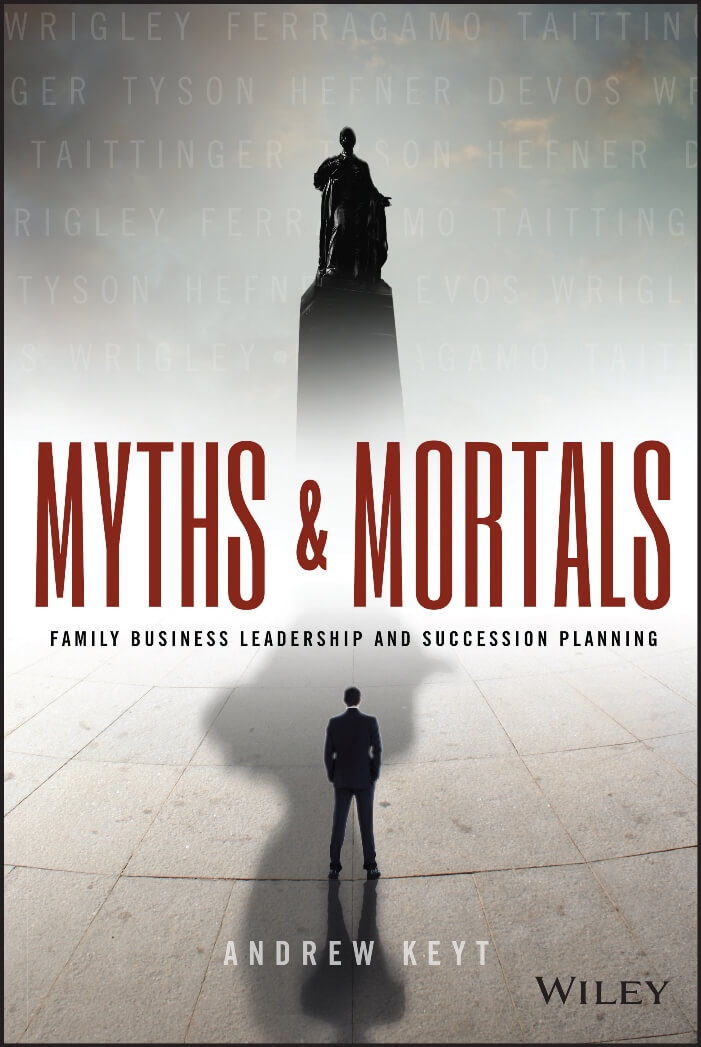Famous family dynasties are riddled with mythology, not least that the patriarch (usually) is the engine room of the business without which it would fail. Andrew Keyt looks to set things right.
Untangling The Family Business 'Myth'
Famous family dynasties are riddled with mythology, not least that the patriarch (usually) is the engine room of the business without which it would fail. Andrew Keyt looks to set things right.

Every myth has its dark side. The myth of a family business is destructive when it becomes egocentric, bolstering the ego of the founder or the collective ego of the family. All the energy of the myth is concentrated on making a hero of a leader rather than energising the entire family across generations.
It doesn’t tap into the passions, beliefs, inspiration, and contribution of others in the family and the business. It is driven primarily by the need to promote the ego of one individual or protect the family image. The myth spins out stories that laud successes, while stripping away the faults, failures, and vulnerabilities that make these people and their families human.
At their best, myths convey truth, but an egocentric mythology creates a feeling of inauthenticity instead. The system seeks to protect its image by pretending that the failures, problems, and vulnerabilities don’t exist. They aggrandize the good and parse out the bad, focusing on heroics rather than incorporating failure into the narrative.
"The faster its pace and the bigger it becomes, the more a business requires a different type of leader"
In fact, an entire area of publishing memorializes this idea—that of vanity press. While not every book written about the founding or history of a family business has the vanity narrative, many do. These are books where larger-than-life leaders seek to legitimize and tell stories of their own greatness.
While this feeds their egos and tells a great story, it can suck the air out of the room for a successor. It seems the legendary leader is responsible for all of this success.
This destructive mythology can create a shadow that eclipses the talent of future family leaders, who are unable to find their sense of identity and strength, to discover their passions, and to determine what beliefs they hold in common with parents and family, and where they differ.
Caught in this shadow, successors can wilt and die. They often succumb to entitlement, addiction, depression, and unhappiness. When the successor gets caught in the shadow, these families tend to deteriorate into infighting, anger, self-protection, and selfishness.
These families tend to produce successors with low self-esteem and self-worth. One-dimensional narratives of a fearless and visionary leader also establish the wrong idea that a successor must also lead without fear, doubt, or vulnerability.
These stories encourage the belief that the successes of their predecessors were magical and repeating similar feats would be impossible. Successors wrongly conclude that in order to be successful, you have to be born with magical (and unattainable) leadership traits.
These myths can also create the idea—as it did for Bill Wrigley Jr., former CEO of the WilliamWrigley Jr. Company—that successors must lead in the way their father/mother led. When a child excessively emulates her parent, she thinks, “My father was a legend, so I must be just like him in order to lead the organization—or not lead at all.” And others surrounding the family business, as in the Steinbrenner case, feed that narrative.
Understanding the Reality of the Myth
We are all born into a story already being told. In the context of a family business, these stories become larger than life and, often, become myths. These stories that we tell are not of one person’s making, they are built on people’s perceptions of what happened, and not what actually happened.
They are often idealized interpretations expressed by many individuals: employees, the community, the press, as well as the parents and successors themselves. Simply, the stories don’t tell the whole story. A founder may have led an organization
through the Depression, like Salvatore Ferragamo—a heroic feat. A founder may have sold paper to Paul Revere to produce the first Continental Currency. The family may have personally sacrificed to avoid layoffs in the Depression.
Or the family may have saved much of Fleet Street during the Nazi bombing of London. But these stories often distort reality by telling only one part of the story. They focus on the positive outcomes, often overlooking challenges and failures and vulnerabilities that led to the success. They combine the stories of many and tell it as if it were one. They create a story of mythic proportions that seems impossible to repeat.
To believe that the success of a parent magically exists apart from his (and often his family’s) sacrifice, the ideas and support of others, good timing, hard work, and a lot or a little luck, is to live in the shadow of the myth.
In retelling the stories, successors create a narrative that further shadows reality: “I can never be like her!” This is shadowland living: to live life in reaction to these stories of the past rather than creating possibilities (and stories) for the future.
The fact is, a predecessor’s qualities and skill sets may not be the qualities and skill sets that the company will need in its leader to move forward. The faster its pace and the bigger it becomes, the more a business requires a different type of leader for it to thrive. The skills needed to start a business and build it to a $50 million company are very different than the skills needed to grow to a $100 million or $200 million company.
Mythologizing also can build up an individual while skimming over the truth that the successes were earned by the hard work of many and the good fortune accumulated over time. Myths don’t account for learning that comes from repeated failure, the dogged persistence, and the small disciplines that form the backbone of greatness.
Instead of tempering these myths and grounding them in reality, children can get caught up in their grandness, projecting their parents as mighty and all-powerful figures. Once that story has built momentum, it is hard to reel in reality. The predecessor keeps getting bigger while the successor shrinks into the shadows.
For a young leader to step out of this shadow, he or she must winnow truth from myth. It’s part of the work that precedes success. Each family’s mythology has a mix of generative qualities and destructive tendencies.
It tells stories that teach values that inspire and unify families, as well as stories that stifle a family’s creative energies. Show me a successful successor in a family business, and I’ll show you someone who sorted through the myth, separated truth from fiction, and began to build on the past with a fresh approach to leadership.
They become generative leaders by leveraging the legacy of their family and building a foundation to meet the needs of future generations.
These successors rewrite the stories that stifle the energy, passion, and creativity of a family, and leverage the generative stories to establish a foundation of values and beliefs that can sustain the health of both family and business. These are generative leaders, who leave a legacy that invigorates and empowers others, laying the foundation for success across generations.
This is an edited extract from Myths and Mortals: Family Business Leadership and Succession Planning by Andrew Keyt, published by Wiley, Hardback and e-book.
Thanks for signing up to Minutehack alerts.
Brilliant editorials heading your way soon.
Okay, Thanks!



